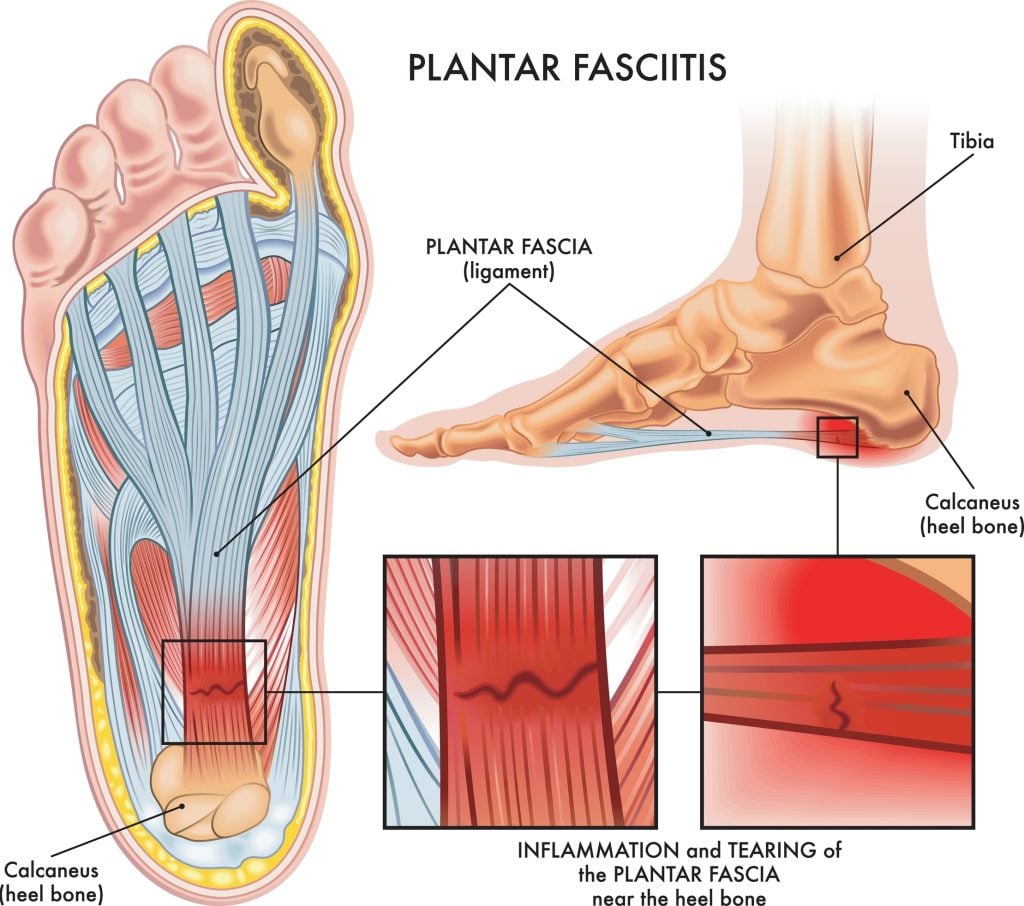If you’re struggling with plantar fasciitis, you’ll recognise the characteristic stabbing pain in your heel that often strikes with your first steps in the morning. This common foot condition affects the plantar fascia, a thick band of tissue connecting your heelbone to your toes, and it’s estimated to impact about 10% of the population annually.
While you’ve likely tried various home remedies, understanding evidence-based podiatric treatments can differentiate between temporary relief and lasting recovery. Let’s examine the proven medical interventions podiatrists employ to address the symptoms and underlying causes of your heel pain.
Key Takeaways
- For effective rehabilitation, perform daily plantar fascia stretches and strengthening exercises, including toe stretches, calf raises, and tennis ball rolls.
- Use custom orthotic devices and supportive footwear for arch support and proper biomechanical alignment during daily activities.
- Apply ice massage and compression techniques to reduce inflammation and promote microtear healing in the plantar fascia.
- Consider advanced therapies like shockwave therapy, night splints, or corticosteroid injections under podiatric supervision for persistent cases.
- Maintain consistent treatment for 8–12 weeks while gradually modifying activities to prevent reinjury and ensure lasting relief.
Understanding Plantar Fasciitis and Heel Pain
A thick band of tissue called the plantar fascia runs down the sole of your foot. This band connects your heel bone to your toes and supports your foot’s arch. Plantar fasciitis, a condition characterised by intense heel pain, typically worsens during your morning steps or after rest periods when this tissue becomes inflamed or damaged.

Understanding the mechanics of plantar fasciitis is essential for effective podiatry treatments. The condition often develops due to repetitive strain, leading to microtears and inflammation in the plantar fascia. Concentrated pain at the heel may radiate throughout the foot arch. Evidence-based treatments, which take a thorough approach, target immediate pain relief and long-term healing.
Your treatment plan may include stretching exercises to improve flexibility, shockwave therapy to stimulate healing, and custom orthotics to provide proper arch support. Taping techniques can also offer temporary relief by supporting the plantar fascia and reducing strain. Addressing the symptoms and underlying causes makes you more likely to achieve lasting relief from this challenging condition.
Heel Pain Treatment Strategies
Plantar fasciitis can effectively alleviate heel pain by incorporating evidence-based treatments into your approach. A detailed treatment plan from your podiatrist should address the condition’s root cause, providing long-term relief and improving overall foot health.
To achieve lasting heel pain relief, your podiatrist will consider the following key treatment strategies:
- Custom orthotics and foot arch support: These provide additional support and stability to the foot arch, thereby reducing strain on the plantar fascia.
- Shockwave Therapy and Immobilisation: Targeting inflammation, promoting healing through shockwave therapy, and immobilising the affected area to prevent further irritation.
- Taping Techniques and Foot Therapy: We use simple taping techniques to provide additional support and stability and incorporate foot therapy to promote healing and relaxation.
A proper diagnosis is essential when developing a personalised treatment plan. Focusing on targeted interventions that address inflammation, support the foot arch, and reduce strain on the plantar fascia can help patients experience long-term relief from plantar fasciitis.

Plantar Fascia Stretching and Strengthening
A targeted stretching and strengthening program based on conservative treatment methods forms the cornerstone of plantar fasciitis rehabilitation. Combining specific exercises recommended by Mayo Clinic and WebMD can significantly reduce plantar pain and prevent recurrence.
Morning Plantar Fasciitis Stretches
Start with gentle morning stretches before getting out of bed, focusing on elongating the plantar fascia and Achilles tendon.
For an effective plantar fasciitis home remedy, you should perform toe stretches, calf raises, and towel pulls several times daily. These exercises help strengthen the small muscles in your feet while promoting flexibility in the plantar fascia.
To get a better understanding of the types of morning stretches to perform, we recommend watching the following video tutorial from the Cleveland Clinic:
Tennis Ball / Frozen Water Bottle Rolls
You can enhance your fasciitis home treatment by incorporating tennis ball rolls and ice massage after activity. Rolling your foot over a frozen water bottle is both a stretching and pain-management strategy.
Here is another useful video tutorial, this time from Baptist Health, on how to perform the tennis ball / frozen water bottle rolls:
As a plantar fasciitis home remedy, it’s essential to maintain consistency with your exercise routine. You should perform these stretches three times daily for at least 10 minutes, focusing on proper form rather than intensity. Remember to start gradually and increase duration as your symptoms improve, always staying within pain-free ranges of motion.
Advanced Foot Therapy Options for Plantar Fasciitis
Embracing advanced foot therapy options enables you to combat the pain associated with plantar fasciitis effectively:
-
Shockwave Heel Therapy
High-energy extracorporeal shockwave therapy (ESWT) offers a promising solution by delivering acoustic waves to stimulate healing in the plantar fascia. This therapy promotes neovascularisation and reduces inflammation, which is crucial to alleviating pain and enhancing foot function.
-
Custom Orthotics
Custom orthotic devices are another essential tool in your arsenal. Tailoring these supports to your unique foot structure realigns biomechanics, mitigates arch strain, and provides necessary cushioning. Personalised orthotics can notably improve symptoms and footwear comfort.
-
Physical Therapy
Physical therapy, mainly manual techniques like soft tissue mobilisation, is vital in improving the range of motion and addressing muscle imbalances that worsen your condition. The functional outcomes are significantly positive when combined with exercises targeting ankle dorsiflexion and intrinsic foot muscles.
-
Night Splints
Night splints are designed to keep your foot in a dorsiflexed position overnight and prevent morning stiffness and pain. Evidence supports their efficacy in maintaining plantar flexibility and expediting recovery.
By integrating these advanced modalities, you’ll be well-equipped to offer meaningful relief to those suffering and enhance their quality of life in a truly impactful way.
Plantar Fasciitis Prevention and Maintenance

Taking proactive steps in plantar fasciitis prevention and maintenance is vital for sustaining foot health and avoiding recurrent pain:
- Begin by incorporating regular stretching exercises focused on your calf muscles and Achilles tendon. Flexibility in these areas can significantly lessen heel pain.
- Evidence suggests that shoes with proper arch support and a cushioned sole reduce plantar fascia strain—consider wearing orthotic insoles for added comfort and stability.
- Weight management plays an essential role in pressure reduction on your feet; maintaining a healthy body weight lessens strain on the plantar fascia and minimises the risk of flare-ups.
- Engage in low-impact exercises like swimming or cycling to maintain cardiovascular health without aggravating your heels.
- You should also listen to your body—if you feel heel discomfort, it's wise to reduce activity and allow rest, giving the fascia time to recover naturally.
- Utilise ice packs to manage inflammation after strenuous activities.
- Lastly, incorporate specific foot-strengthening exercises into your routine. Strengthening small intrinsic foot muscles supports the foot arch, creating a stable foundation.
Empowering yourself with these preventive measures is effective for maintaining foot health and maximising your ability to serve others without succumbing to debilitating heel pain.
When to Seek Professional Heel Therapy
The decision to seek professional intervention for heel pain should be based on specific clinical indicators. When your self-management strategies aren’t providing adequate relief, it’s essential to consult a qualified podiatrist who can properly diagnose and treat your plantar fasciitis.

Early professional intervention can prevent the condition from becoming chronic and potentially causing long-term biomechanical complications:
- You're experiencing persistent heel pain that lasts more than three weeks despite rest and basic home care measures.
- Your pain is severe enough to limit daily activities, affect your gait, or prevent you from bearing weight typically.
- You notice significant swelling, redness, or warmth around your heel area, which could indicate acute inflammation.
- You experience numbness, tingling, or radiating pain that runs up your leg and heel pain.
An experienced heel pain podiatrist will conduct a thorough biomechanical assessment, evaluate your foot’s structure, and analyse your gait pattern to determine the underlying causes of your condition.
We will develop a personalised treatment plan that may include advanced therapeutic interventions, such as shockwave therapy, custom orthotics, or specialised taping techniques, to address your specific needs.
Summing It All Up...
To cure plantar fasciitis and achieve lasting heel pain relief, adopting a comprehensive treatment strategy incorporating evidence-based podiatry practices is crucial.
This includes regular stretching exercises to improve flexibility, wearing supportive shoes with proper arch support, and leveraging specialised therapies such as physical therapy, night splints, orthotics, and, in some cases, shockwave therapy.
Early intervention and adherence to science-backed solutions are key to preventing severe setbacks and maintaining strength and flexibility. Committing to diligent daily care and consulting with supportive specialists, like those at Bellevue Podiatry, can achieve dynamic and dependable relief.
Contact Bellevue Podiatry today to schedule an appointment and start your journey to pain-free living.
If you want the right professional advice on how to treat your heel pain, we currently have a limited offer running to help you out. For just $79 (usually valued at $189), book in online for our Complete Heel Pain Assessment & Treatment Consultation will get:
- Complete In-Depth Heel Pain Examination
- Review of Footwear & Personal Habit Diagnosis
- Treadmill Walking Gait Analysis & Video Assessment
- Complete Foot & Ankle Structural Diagnosis
- Effective Heel Pain Treatment Plan To Get You Walking Pain Free
- Peace of Mind You Know What Is Causing Your Heel Pain & How To Fix It
Heel Pain & Plantar Fasciitis
Understand what causes your heel pain and what you can do to get rid of it once and for all. Find out what treatments can get you back to walking pain free so you can enjoy living an active life again!


Bellevue Podiatry
Bellevue Podiatry has been serving the people of Rosanna and its surrounding suburbs for over 10 years. We have the qualifications, experience and education to effectively treat any lower limb condition or injury that requires expert podiatry care.
Plantar Fasciitis Article References:
If you would like a deeper understanding of the treatment podiatrists use for plantar fasciitis, please click on the links below:
- Mayo Clinic: https://www.mayoclinic.org/diseases-conditions/plantar-fasciitis/diagnosis-treatment/drc-20354851
- Harvard Health: https://www.health.harvard.edu/pain/plantar-fasciitis-symptoms-causes-and-treatments
- WebMD: https://www.webmd.com/fitness-exercise/what-can-i-do-plantar-fasciitis
- PubMed: https://pubmed.ncbi.nlm.nih.gov/21794421/
- NCBI Bookshelf: https://www.ncbi.nlm.nih.gov/books/NBK431073/
